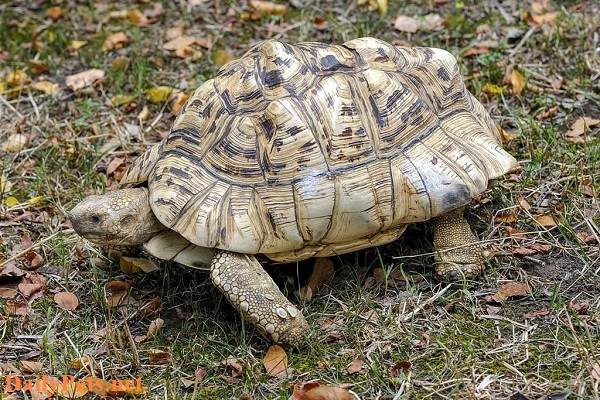Many often mistake the North American box turtle for land turtles because they look similar. Although they may look alike, the Box Turtle of North America is an American pond turtle family member.
There are many interesting aspects to the life of the Box Turtle in North America. This article from DailyPets.net will introduce you to some fascinating facts about the Box Turtle of North America, including how long these little turtles can live.
The lifespan of the Box Turtle of North America
Currently, there are four species of Box Turtles in North America. Depending on the species, the shells of box turtles may have various colors.
Some box turtles may have brown-colored shells, while others have shells with yellow patches. The shell of the Box Turtle covers most of its body and has ridges. The Box Turtle of North America also has webbed toes and a hooked beak. The length of a Box Turtle in North America is approximately 6 inches.

North American box turtle.
Their natural habitat is near grasslands, fields, and ponds. They prefer warmer weather, seeking shade if it becomes too hot. They search for food on cooler days, enjoying fruits, berries, flowers, and insects.
If a North American box turtle feels threatened, it will retract into its shell and close it securely. The box turtle’s shell has extremely high flexibility, making it difficult for predators to attack.
Box turtles also live secretive lives, enjoying privacy by hiding in wood crevices or digging deep into sand and mud. Some species of Box Turtles in North America even hibernate during colder months when food is scarce and harder to find.
How Long Do Box Turtles of North America Live?
The average lifespan of the Box Turtle of North America in the wild is 40 to 50 years. However, North American box turtles have been known to live up to 100 years in captivity. The environment plays a crucial role in their lifespan. Unfortunately, counting growth rings on a box turtle’s shell in the wild is not a reliable way to estimate their age.
There are several North American box turtle species, each with different lifespans. Here are some species, along with their average lifespans:
- Desert Box Turtle: 10 to 50 years.
- Eastern Box Turtle or Land Turtle: 25 to 35 years in the wild and possibly over 100 years in captivity.
- Florida Box Turtle: 25 to 30 years in the wild and over 50 years in captivity.
- Yucatan Box Turtle (not widely studied): Estimated to live over 100 years in the wild.
Life Cycle of the North American box turtle
The life cycle of the box turtle is quite similar to many other wild turtle species. Let’s examine each stage in detail:
Nesting
The North American box turtle prefers to lay eggs in water or mud. The female box turtle constructs a nest for laying eggs, roughly the size of the turtle herself and deep enough for egg deposition. It takes 6 to 8 weeks for the box turtle eggs to hatch.
Hatchlings
After 6 to 8 weeks, the hatchlings begin to emerge. The female box turtle does not stay with her eggs during this time. The hatchlings slowly start to crack open the eggshells, which can take 2 or 3 days. Eventually, when they have emerged from the eggs and dug their way out of the nest, they are free to explore and must fend for themselves.
Adulthood
Box turtles reach maturity and begin mating between 10 and 20. This is also when they display their most vivid and vibrant colors. Box Turtles of North America began seeking other turtles for mating during this period.
Factors Affecting the Lifespan of North American box turtle
Although box turtles can live long, only a small percentage reach adulthood. Here are some factors that can negatively impact the lifespan of North American box turtles:
Habitat Destruction
The natural habitat of box turtles is being destroyed in various ways, such as the destruction of wetlands, river channel alterations, and changes in the landscape.
Box turtles are extremely sensitive to changes in water quality, and living in polluted or dirty water can have adverse effects. Climate change and air and water pollution also begin to harm them. Additionally, the expansion of cities, roads, and towns…
Invasive Species
Invasive plant species can affect the lifespan of box turtles. The turtle population can be severely reduced when bacteria, viruses, and parasites are affected.
Female box turtles can lay thousands of eggs throughout their lives, but if they become prey, they won’t be able to lay eggs.
Human Factors
One of the major threats to box turtles today is the increasing demand for them as pets. However, many people lack the necessary knowledge and research before obtaining them. If you want to keep a box turtle as a pet, it’s crucial to learn and thoroughly research before starting.

